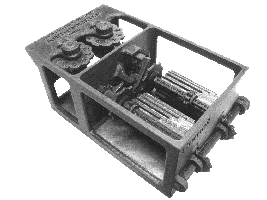 | |||||||||||||||||
| |||||||||||||||||
Progress
The objective of the project was to create a working SolidWorks model of the Arithmometer. The process leading up to the first printing (pictured at right) is summarized below.
Examine technical drawings of the device
Because Cornell does not own an Arithmometer, it was impossible to study an actual device to use for the creation of the model. This capability came from 19th century drawings made by Franz Reuleaux around 1860 when he studied how the device worked.
Create a 3D model using SolidWorks
In creating the model, it was important to stay as true to the original design as possible. However, due to the limitations of rapid prototyping, this was not entirely possible. Some pieces having very small features, particularly in the carry mechanism, and had to be modified.
Validate the dynamics of the model in CosmosMotion
CosmosMotion is an add-on to SolidWorks which provides dynamic simulation analysis for the assembly. With over 10 moving parts in the model, this tool was helpful in determining the quality of the model and predicting its ability to function when rapid prototyped.
Print the model via rapid prototyping
Rapid prototyping is a process by which a 3D model is printed without any need for assembly. Essentially, the printer prints the model layer by layer using two materials--one of which is later dissolved away. The printing process took a total of 90 hours.
Identify any problems with the model and improve the design
The rapid prototype process has a big advantage of not requiring any assembly of the device once it is printed. However, it also has the drawback of requiring a gap between all moving parts. This can introduce small errors in the timing on the device.
|
|||||||||||||||||
| This page and all its contents © 2005 by Tim Kostka | |||||||||||||||||


